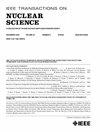Micro-Columnar CsBr:Eu Storage Phosphor for High-Efficiency High Energy Photon Radiography Panels
IF 1.9
3区 工程技术
Q3 ENGINEERING, ELECTRICAL & ELECTRONIC
引用次数: 0
Abstract
Eu-doped CsBr films (CsBr:Eu) exhibit excellent sensitivity for X-rays and are superior storage phosphors for high energy (MeV) photon radiography applications when coupled with thick copper or tungsten substrates. We report on the growth of micro-columnar CsBr:Eu films on copper substrates for megavolt (MV) X-ray imaging applications. Our films exhibit dense uniformly distributed micro-columns with an average diameter of用于高效高能光子射线照相术面板的微柱状 CsBr:Eu 储存荧光粉
掺杂 Eu 的铯硼薄膜(CsBr:Eu)对 X 射线具有极佳的灵敏度,与厚铜或钨基板结合使用时,是高能量(MeV)光子射线成像应用的优质存储荧光粉。我们报告了在铜基底上生长微柱状 CsBr:Eu 薄膜以应用于兆伏特 (MV) X 射线成像的情况。我们的薄膜呈现出致密均匀分布的微柱,其平均直径为 $\sim 10~\mu $ m,顶部呈尖锐的针状。这种微柱状结构薄膜的优势在于,光线可以通过狭窄的柱状结构导入,从而提高透光率和空间分辨率。我们还确定了 CsBr 中 Eu 的最佳浓度,以获得最佳的存储荧光粉性能。在 $2^{\prime \prime } 上生长出了厚度均匀的微柱状结构薄膜,最厚可达 2 毫米。\金属基底上生长出厚度达 2 毫米的均匀微柱状结构薄膜,然后用光激发发光(OSL)和 X 射线激发对其进行表征。此外,5 毫米厚的薄膜生长证明了将其扩展到更厚薄膜的潜力。
本文章由计算机程序翻译,如有差异,请以英文原文为准。
求助全文
约1分钟内获得全文
求助全文
来源期刊

IEEE Transactions on Nuclear Science
工程技术-工程:电子与电气
CiteScore
3.70
自引率
27.80%
发文量
314
审稿时长
6.2 months
期刊介绍:
The IEEE Transactions on Nuclear Science is a publication of the IEEE Nuclear and Plasma Sciences Society. It is viewed as the primary source of technical information in many of the areas it covers. As judged by JCR impact factor, TNS consistently ranks in the top five journals in the category of Nuclear Science & Technology. It has one of the higher immediacy indices, indicating that the information it publishes is viewed as timely, and has a relatively long citation half-life, indicating that the published information also is viewed as valuable for a number of years.
The IEEE Transactions on Nuclear Science is published bimonthly. Its scope includes all aspects of the theory and application of nuclear science and engineering. It focuses on instrumentation for the detection and measurement of ionizing radiation; particle accelerators and their controls; nuclear medicine and its application; effects of radiation on materials, components, and systems; reactor instrumentation and controls; and measurement of radiation in space.
 求助内容:
求助内容: 应助结果提醒方式:
应助结果提醒方式:


